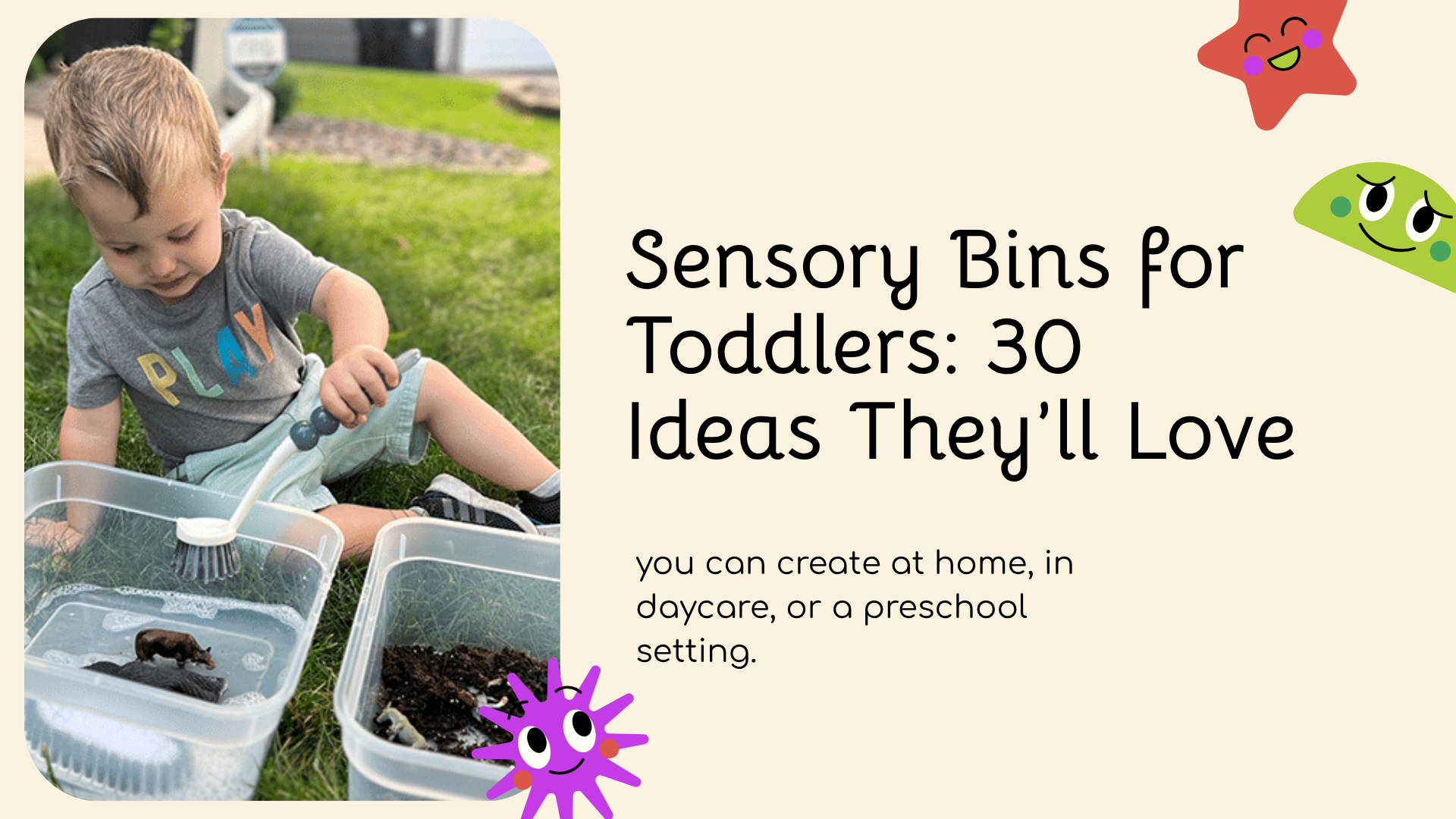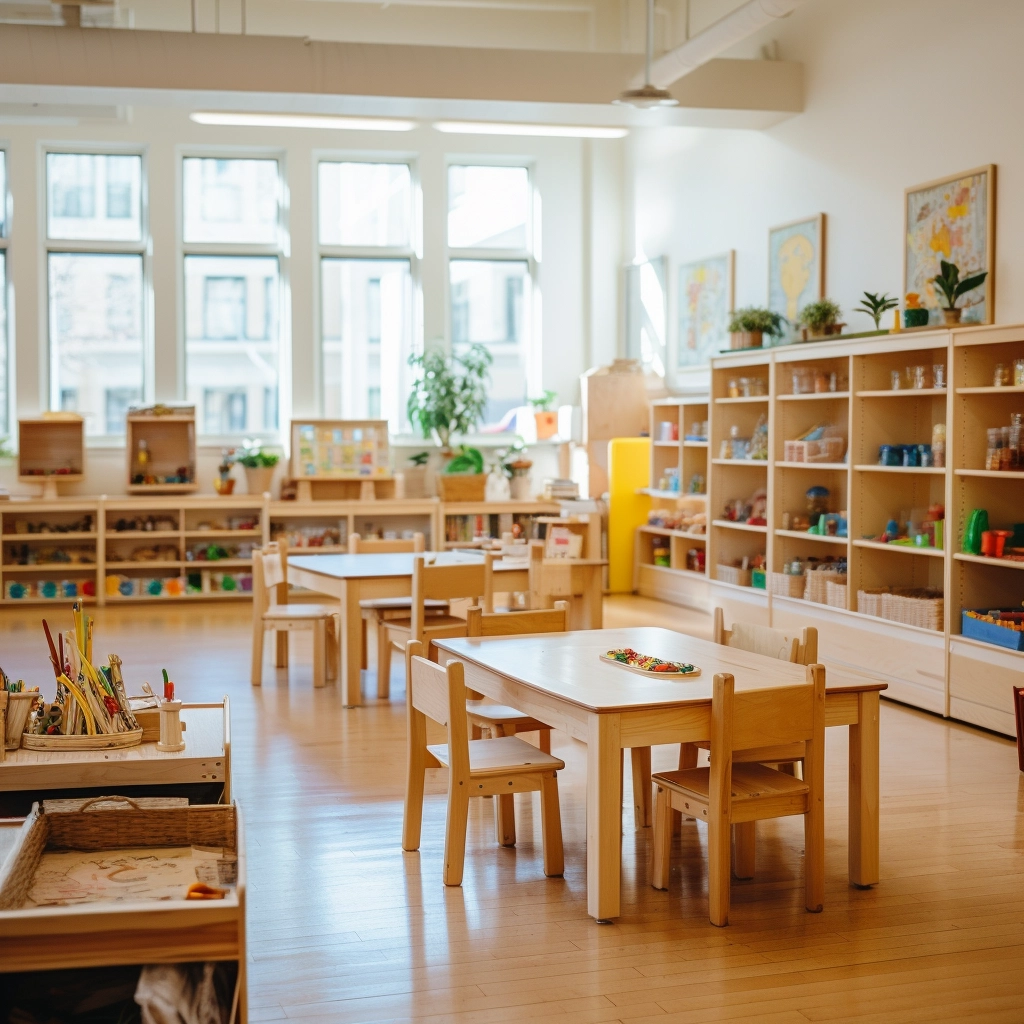Looking for ways to engage your child that go beyond toys and screens? Ever feel like your little one craves something hands-on, calming, and meaningful? That’s where sensory bins for toddlers come in. They turn everyday materials into magical play that supports curiosity and early development.
More than just a fun activity, sensory bins for toddlers provide powerful developmental benefits. They help strengthen ทักษะการเคลื่อนไหวที่ดี, promote independent play, and support emotional regulation. At the same time, they keep those busy little hands engaged and focused. Whether your child is scooping, sorting, or discovering new textures, every moment spent exploring a sensory bin contributes to brain development and sensory learning.
In this article, I’ll share 30 imaginative and easy-to-make sensory bins for toddlers that you can create at home, in daycare, or in a preschool setting. Get ready to transform simple items like rice, water, or pasta into playful adventures your child will love.
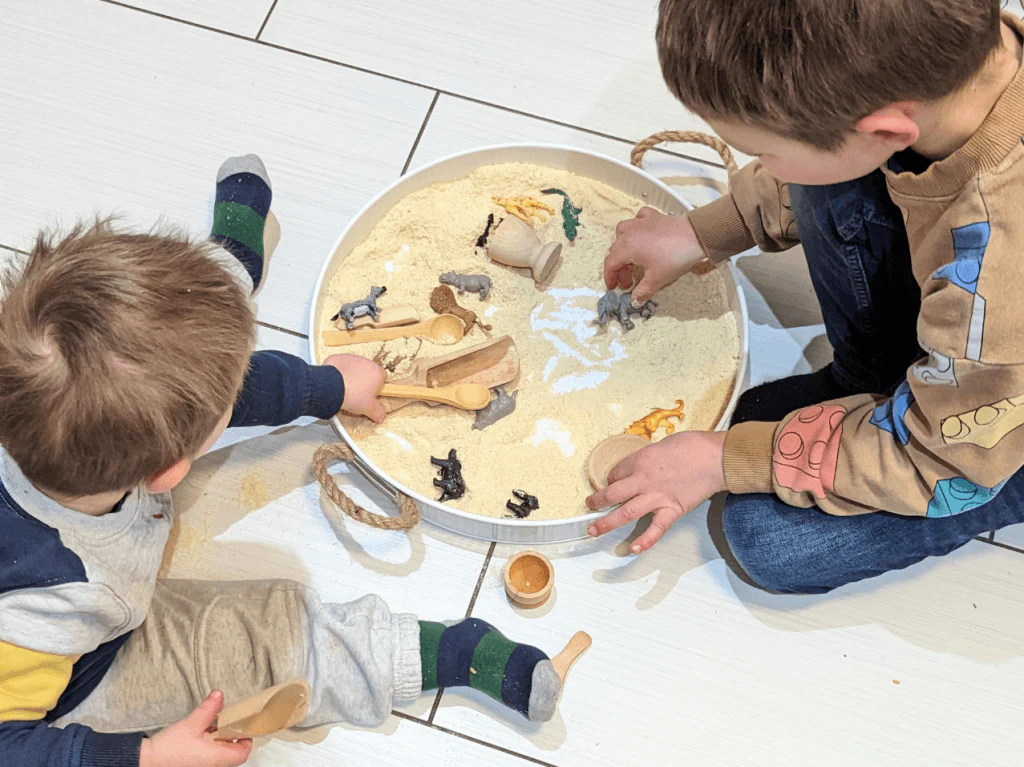
What are Sensory Bins for Toddlers?
Sensory bins for toddlers are hands-on play containers designed to stimulate a child’s senses, including touch, sight, sound, and sometimes even smell or taste. At their core, these bins are simply shallow containers filled with themed materials that encourage open-ended exploration. Think of a plastic bin filled with rice, toy animals, measuring cups, and spoons. While it may look like “just play,” it’s a purposeful, brain-boosting activity tailored for early development.
The beauty of sensory bins lies in their simplicity. Whether you’re using dried pasta, kinetic sand, or water with floating toys, each material provides a different sensory experience. Toddlers love to scoop, pour, dig, shake, and explore freely. Sensory bins offer a safe and engaging space that encourages all of this natural behavior. This type of play supports curiosity and lays the foundation for critical thinking, creativity, and fine motor coordination.
Benefits of Sensory Bins for Toddlers
Sensory bins for toddlers provide meaningful opportunities for children to grow, explore, and build essential life skills. From strengthening fine motor coordination to supporting emotional balance, sensory play engages the whole child in ways that traditional toys cannot. The following benefits highlight why sensory bins are such a powerful tool in early childhood development.
Support Fine Motor Development
Sensory bins for toddlers help build essential ทักษะการเคลื่อนไหวที่ดี through hands-on exploration. Simple actions like scooping, pinching, pouring, and sorting engage the small muscles in the hands and fingers, which are later used for writing, buttoning, and feeding. The tactile nature of sensory bins provides repetitive, purposeful movement that strengthens coordination naturally and playfully.
Encourage Cognitive Growth
Sensory bins for toddlers support early thinking and problem-solving. As children manipulate objects, organize materials, and complete small tasks within the bin, they are developing focus, logical thinking, and spatial awareness. Whether sorting by color or following simple play sequences, toddlers are constantly making decisions and forming connections between actions and outcomes.
Boost Language and Communication
Open-ended sensory play encourages toddlers to describe what they see, feel, and do. This verbal expression builds vocabulary and supports early communication skills. During sensory bin play, children often talk aloud or ask questions, engaging caregivers or peers in meaningful dialogue. These moments are rich in language development, especially when the materials inspire storytelling or pretend play.
Stimulate the Senses
As the name suggests, sensory bins engage a child’s senses. Different textures, temperatures, and colors stimulate curiosity and sensory processing. By interacting with a variety of materials, toddlers begin to understand differences in texture, weight, and resistance, which strengthens their sensory integration and ability to interpret the world around them.
Promote Emotional Regulation
Sensory bins provide a soothing and structured outlet for toddlers to calm themselves. The repetitive nature of scooping or sifting can help reduce anxiety and bring a sense of control. For many children, sensory play becomes a reliable tool for emotional balance, helping them transition between activities or recover from overstimulation safely and quietly.
Encourage Independent Play
Sensory bins for toddlers are ideal for fostering independence. The open-ended nature of the materials allows children to make choices, set their own goals, and solve small challenges without adult direction. This kind of play promotes confidence, self-direction, and patience, which are foundational skills in early childhood learning and development.
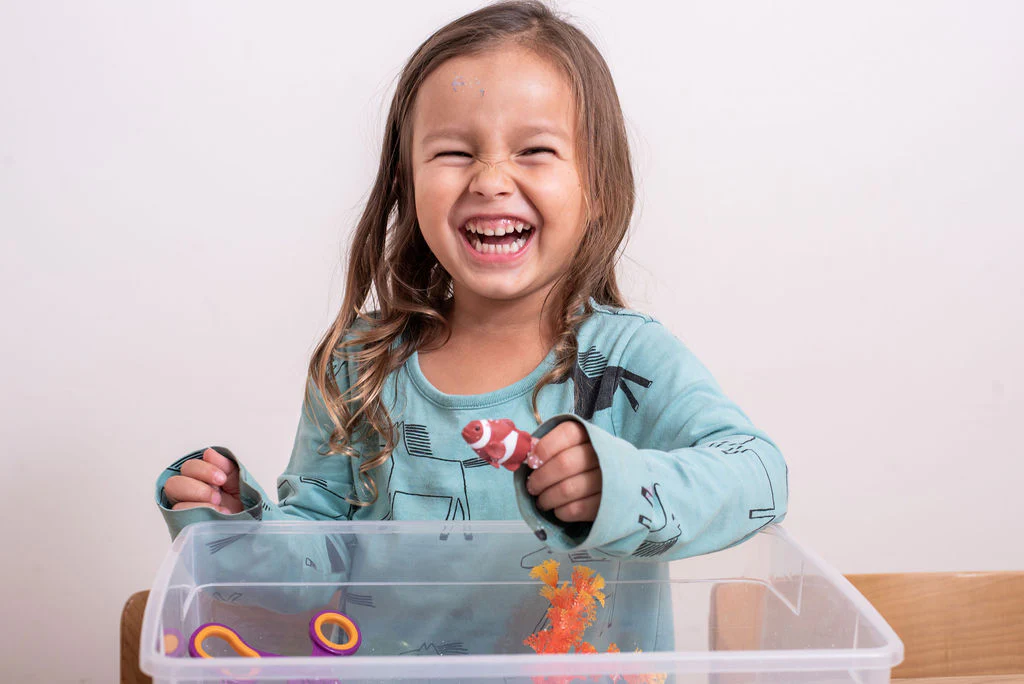
30 Sensory Bins for Toddlers
Sensory bins for toddlers can be created with simple materials yet provide endless opportunities for learning and play. Each idea introduces a new way for children to explore textures, practice fine motor skills, and develop patience through hands-on discovery. The following 30 sensory bin activities are easy to set up at home, in a daycare, or in a preschool classroom:
1. Rainbow Rice Bin
การแนะนำ
This colorful bin is a classic. It encourages toddlers to practice scooping, pouring, and mixing, while also introducing color recognition and sensory contrast. It’s a highly engaging option for indoor sensory play.
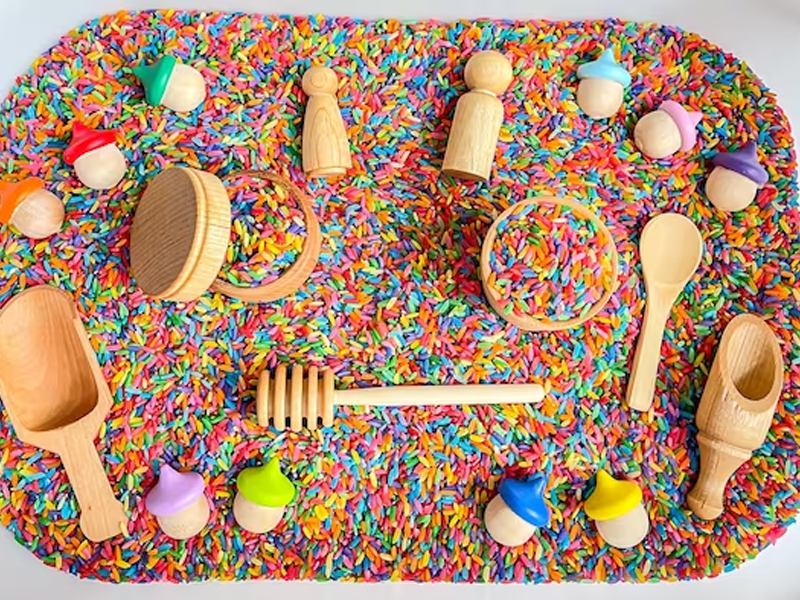
วัสดุ
- Cups, scoops, funnels
- Uncooked white rice
- Food coloring (red, blue, yellow, green)
- Ziplock bags
- A large plastic bin
How to Make It
- Divide rice into separate ziplock bags.
- Add a few drops of food coloring to each bag, seal, and shake to color the rice.
- Spread rice on a tray to dry for a few hours.
- Once dry, pour all colors into the bin.
- Add scoops and cups for play.
2. Water Play Bin
การแนะนำ
A calming and straightforward sensory bin for toddlers that introduces liquid movement, floating vs. sinking, and basic motor skills like pouring and splashing. Ideal for hot days or water-based lessons.
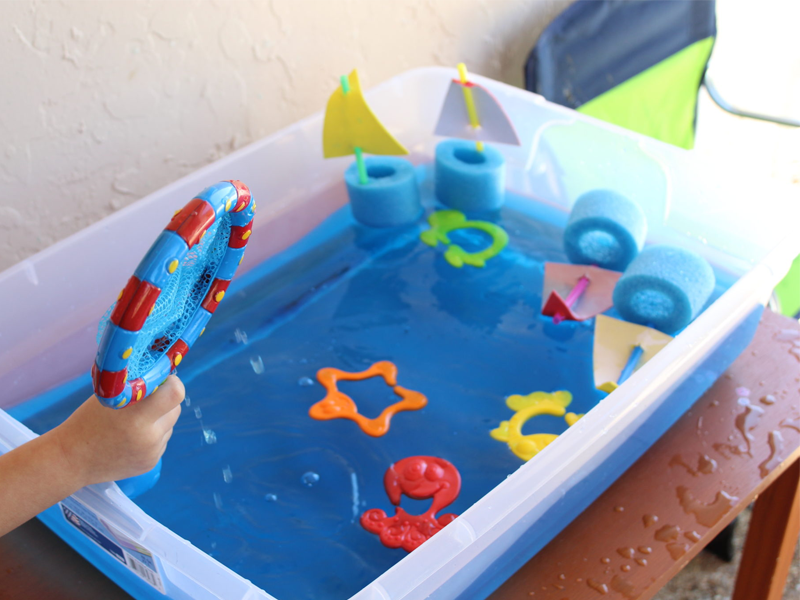
วัสดุ
- Towels for cleanup
- Shallow plastic container
- น้ำอุ่น
- Small plastic cups or ladles
- Floating toys (ducks, boats, balls)
How to Make It
- Fill the bin halfway with clean, warm water.
- Place floating toys inside.
- Add scoops, cups, and ladles on the side.
- Let toddlers explore pouring, splashing, and collecting.
3. Dry Pasta & Scoop Station
การแนะนำ
This dry sensory bin strengthens fine motor skills and hand-eye coordination. It’s also helpful in introducing sorting by shape, size, or color if multiple pasta types are used.
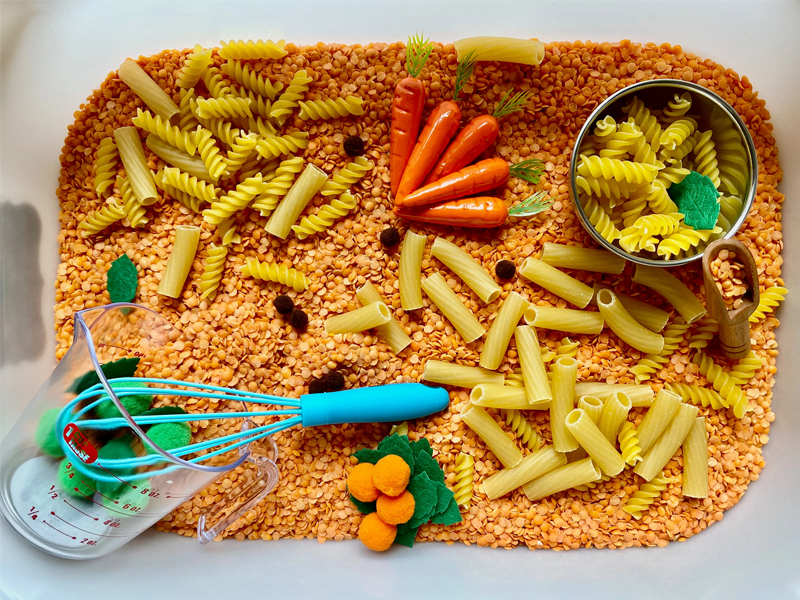
วัสดุ
- Plastic spoons or small containers
- Assorted dry pasta (penne, rotini, shells, etc.)
- Medium-sized bin
- Measuring cups
How to Make It
- Fill the bin with a variety of dry pasta.
- Add measuring cups and spoons.
- Encourage toddlers to scoop, pour, and sort.
- Optional: Use colored pasta for added visual appeal.
4. Nature Bin
การแนะนำ
This outdoor-inspired bin introduces natural textures and objects, helping toddlers connect with nature and practice sensory discrimination. Great for seasonal themes or outdoor classrooms.
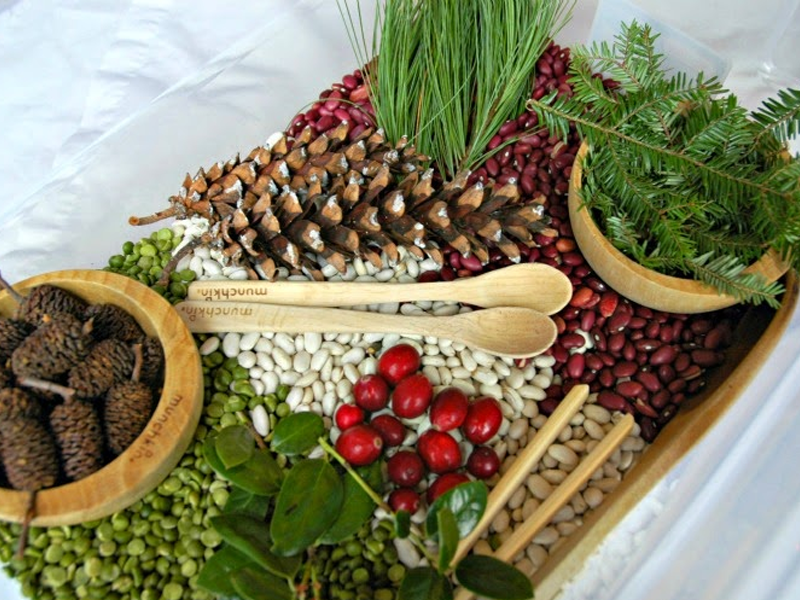
วัสดุ
- A large bin or tray
- Dry leaves
- Small sticks or twigs
- Pinecones
- Pebbles or smooth stones
How to Make It
- Gather natural materials during a walk or from your garden.
- Place all items into a clean plastic bin.
- Let toddlers touch, smell, and arrange the objects freely.
- Offer tongs or cups if you want to encourage more fine motor use.
5. Ice and Water Bin
การแนะนำ
The ice and water bin gives toddlers a playful way to explore temperature contrasts while engaging their senses of touch and sight. As the ice melts and mixes with warm water, children practice observation, patience, and cause-and-effect thinking. The activity also encourages fine motor skills as little hands scoop, stir, and experiment with the changing textures.
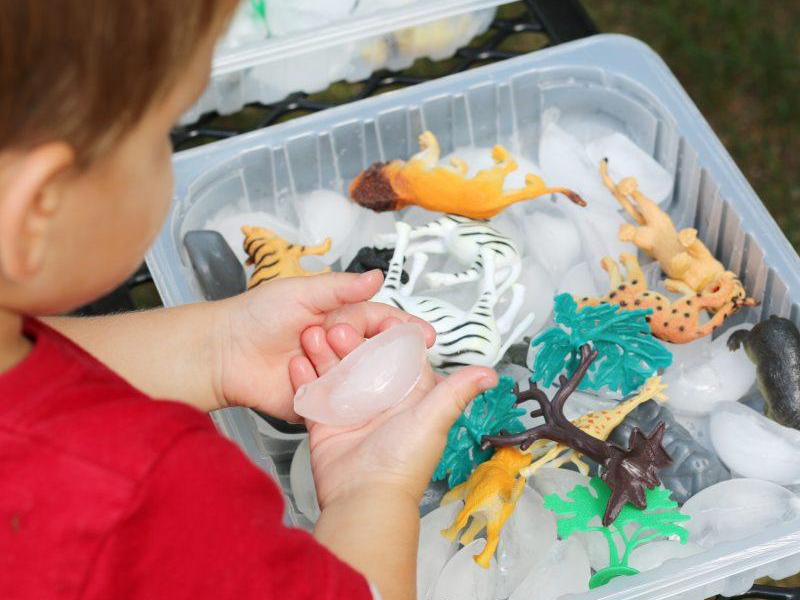
วัสดุ
- Small plastic toys (optional)
- Ice cubes
- น้ำอุ่น
- Plastic bin
- Measuring cups or spoons
How to Make It
- Fill the bin with a mix of ice and warm water.
- Drop in plastic toys if desired.
- Add spoons or scoops.
- Let toddlers splash, stir, and observe the changes in temperature and texture.
6. Pom-Pom Sorting Bin
การแนะนำ
This colorful sensory bin helps toddlers practice color recognition and sorting while strengthening their pincer grasp and coordination. It’s a quiet and calming activity ideal for independent play.
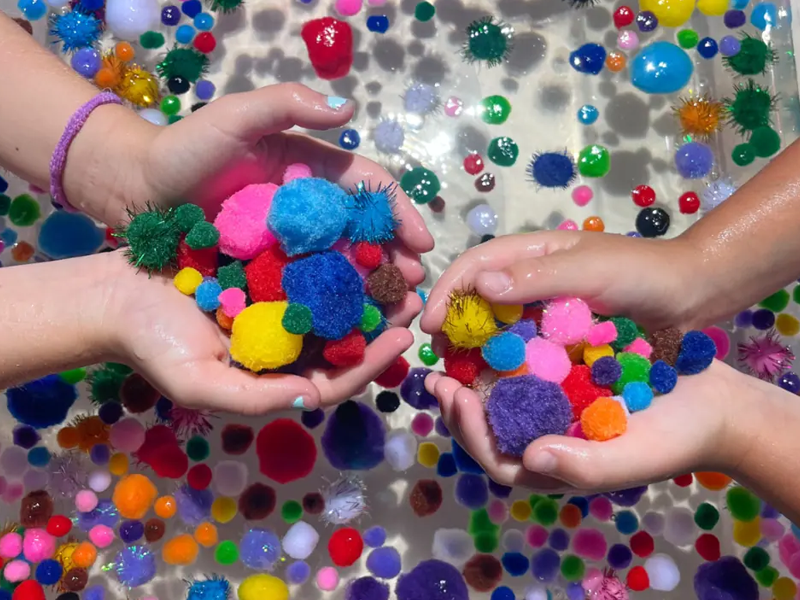
วัสดุ
- Medium-sized bin
- Soft pom-poms in various colors
- Muffin tin or small bowls
- Child-safe plastic tweezers or tongs
How to Make It
- Fill the bin with assorted pom-poms.
- Place muffin tins or bowls nearby, one for each color.
- Add tweezers or tongs to encourage fine motor use.
- Invite toddlers to sort the pom-poms by color.
7. Edible Cereal Bin
การแนะนำ
Perfect for younger toddlers still in the mouthing phase, this sensory bin uses edible materials to ensure safe exploration. It supports scooping and pouring while introducing texture and scent.
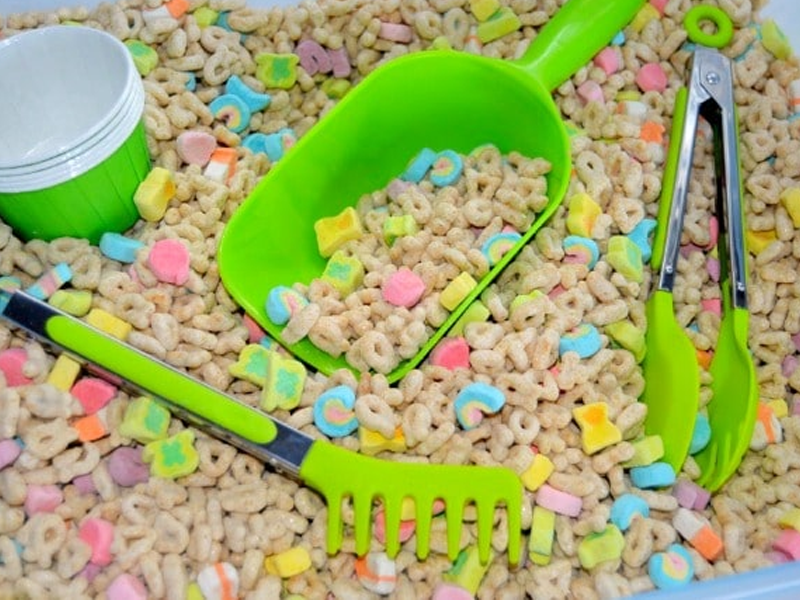
วัสดุ
- Clean surface or play mat underneath
- Puffed cereal (like Cheerios or rice puffs)
- Medium plastic bin
- Scoops, spoons, and small cups
How to Make It
- Pour cereal into the bin until the bottom is well-covered.
- Add scoops, cups, and spoons.
- Let toddlers dig, pour, and snack if desired.
- Always supervise to avoid choking.
8. Bubble Foam Bin
การแนะนำ
A fun and fluffy bin that introduces new textures, this activity is great for sensory seekers. The foam is light, safe, and exciting to touch, making it a standout toddler sensory bin.
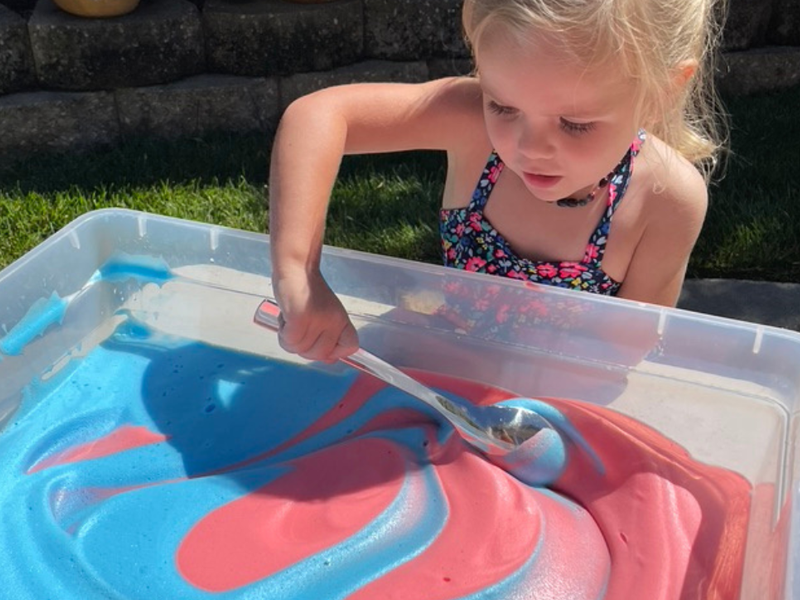
วัสดุ
- Bin or large tray
- 2 tablespoons of dish soap
- 1/4 cup water
- Hand mixer or whisk
- สีผสมอาหาร (ไม่จำเป็น)
How to Make It
- Combine dish soap and water in a bowl.
- Whip with a hand mixer until stiff peaks form.
- Add food coloring if desired.
- Fill the bin with foam and let toddlers explore with their hands or tools.
9. Sand & Shells Bin
การแนะนำ
This beach-themed bin introduces toddlers to coarse and smooth textures while supporting pretend play. It’s a relaxing, imaginative activity for sensory development and storytelling.
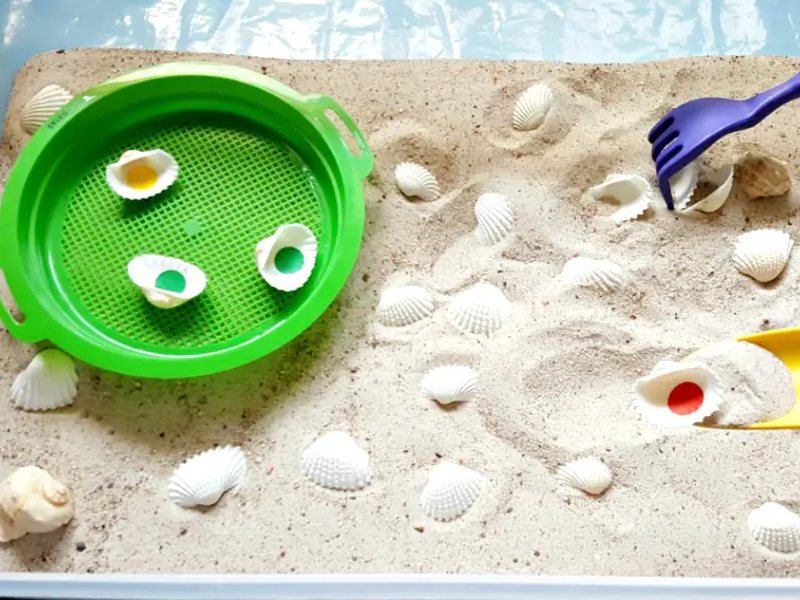
วัสดุ
- Medium to large bin
- Clean play sand
- Plastic or real shells
- Small beach toys (shovels, buckets)
How to Make It
- Fill the bin with 1–2 inches of play sand.
- Bury or place shells throughout the bin.
- Add mini shovels and pails.
- Encourage toddlers to dig, scoop, and collect their “beach treasures.”
10. Scoop-the-Beans Bin
การแนะนำ
This classic sensory bin for toddlers is ideal for hand strength, coordination, and simple counting practice. Toddlers enjoy the sound, weight, and movement of the beans as they play.
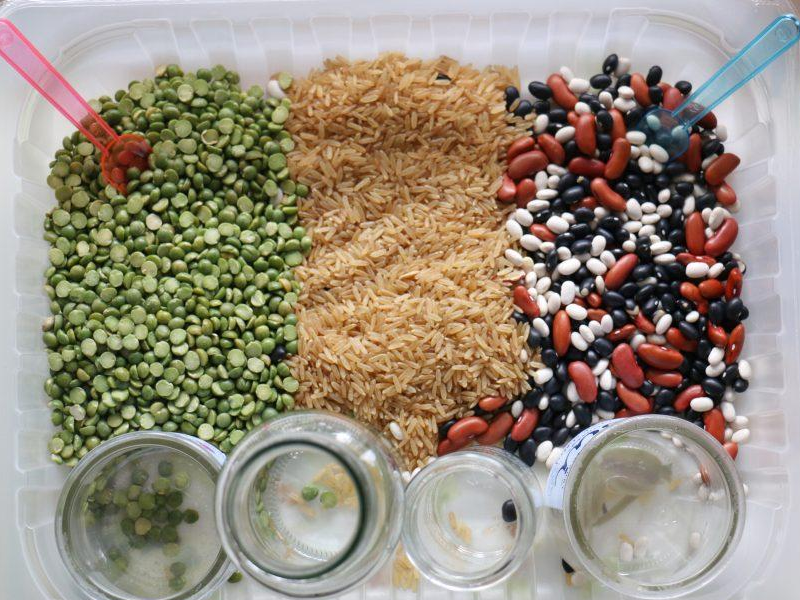
วัสดุ
- Small bowls or trays
- Dried black beans or kidney beans
- Plastic bin
- Scoops, cups, funnels
How to Make It
- Pour dried beans into the bin.
- Add scoops and funnels.
- Provide small bowls to transfer beans into.
- Toddlers can scoop, pour, and count as they play.
พร้อมที่จะออกแบบพื้นที่ที่สร้างแรงบันดาลใจในการเรียนรู้หรือยัง ติดต่อเราเพื่อสร้างโซลูชันเฟอร์นิเจอร์ที่ปรับแต่งให้เหมาะกับความต้องการในห้องเรียนของคุณ
11. Cotton Ball Snow Bin
การแนะนำ
Soft, quiet, and safe, this sensory bin is perfect for winter themes or calming activities. Toddlers can explore gentle textures and practice scooping or building “snow piles.”

วัสดุ
- Plastic scoops or tongs (optional)
- Cotton balls
- Bin or tray
- Small cups or containers
How to Make It
- Fill the bin with a layer of cotton balls.
- Add scoops, cups, and tongs to encourage motor skills.
- Invite toddlers to scoop, pile, or transfer the “snow.”
- Optional: Add foil pieces or snowflake cutouts for visual interest.
12. Gelatin Dig Bin
การแนะนำ
The gelatin dig bin provides toddlers with a playful way to explore a new texture while strengthening their fine motor skills. As they scoop or dig into the firm surface, children uncover hidden toys and practice patience, hand-eye coordination, and problem-solving. The wobbly, colorful base also sparks curiosity and makes the activity both engaging and educational.
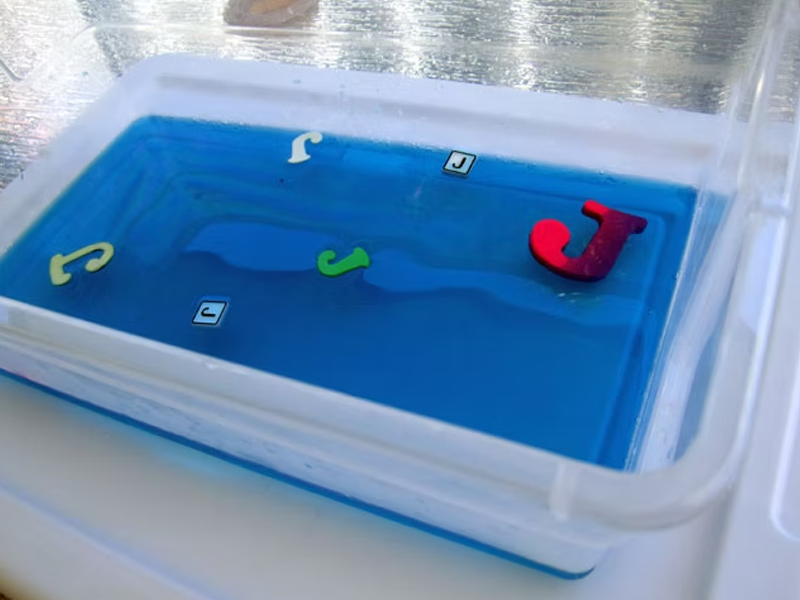
วัสดุ
- Spoons or scoops
- Clear gelatin (unflavored or flavored)
- Small plastic toys (animals, shapes)
- Clear container
How to Make It
- Prepare gelatin and pour it into a container with small toys inside.
- Refrigerate until fully set.
- Place the container in a larger bin or tray to contain the mess.
- Offer spoons or let toddlers use their hands to dig and discover.
13. Construction Zone Bin
การแนะนำ
This bin encourages pretend play and gross motor movement through a tactile, construction-themed setup. It’s a significant sensory bin for toddlers who love vehicles and active exploration.
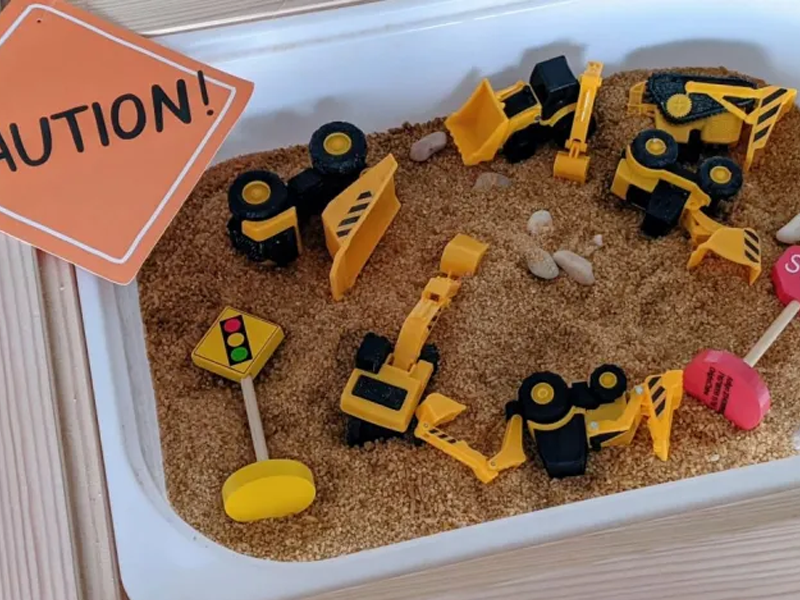
วัสดุ
- Sturdy bin
- Kinetic sand or dry oats
- Toy dump trucks, bulldozers, and scoops
- Small plastic blocks or rocks
How to Make It
- Fill the bin with a base layer of kinetic sand or oats.
- Add construction vehicles and small building elements.
- Let toddlers scoop, push, load, and dump like a real worksite.
- You can even tape off “roads” inside the bin for added fun.
14. Color Match Rice Bin
การแนะนำ
This activity combines sensory play with early color recognition and sorting skills. Toddlers use their eyes and hands together to match colored rice to matching containers.
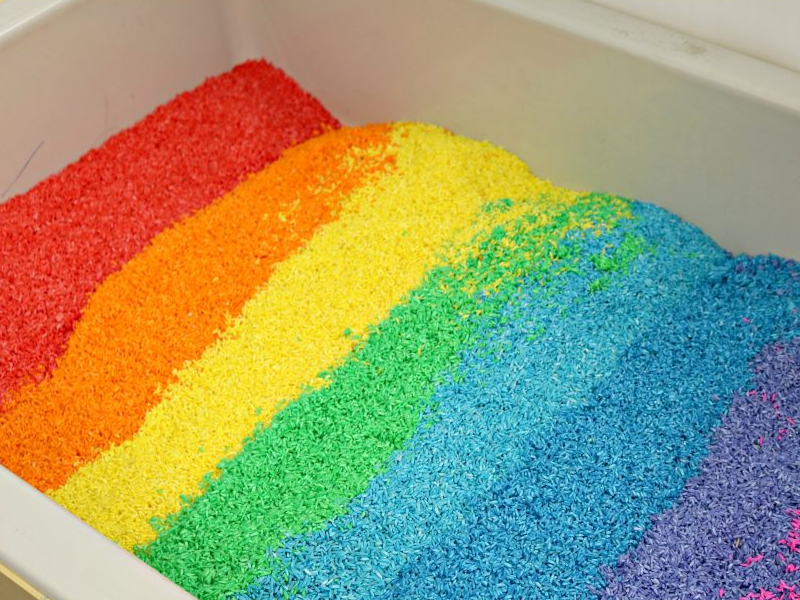
วัสดุ
- Medium-sized bin
- Dyed rice in 3–4 different colors
- Matching colored cups or bowls
- Scoops or spoons
How to Make It
- Dye rice in separate batches and let it dry completely.
- Pour mixed colors into the bin.
- Place matching colored cups nearby.
- Toddlers scoop and sort the rice by color into the correct container.
15. Water Beads Sensory Bin
การแนะนำ
Water beads offer a cool, squishy texture that toddlers find irresistible. This bin promotes sensory curiosity and fine motor development through scooping and sorting.
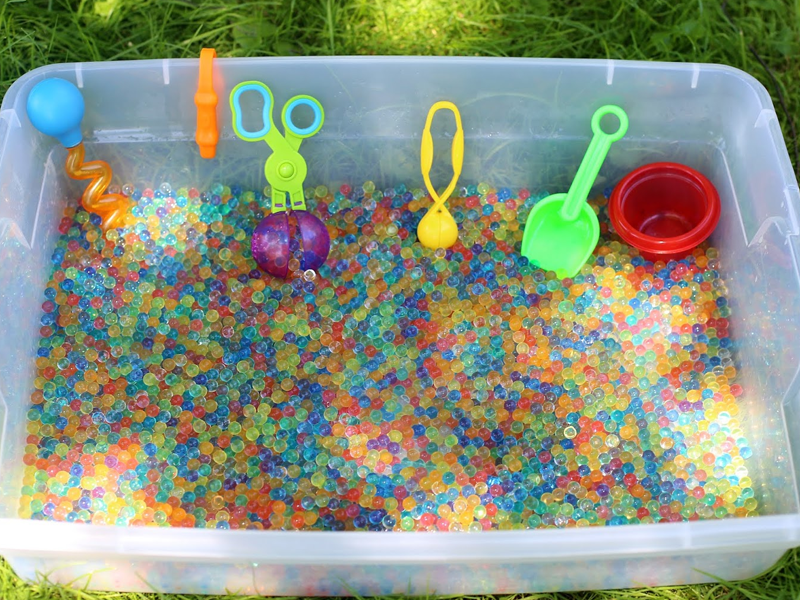
วัสดุ
- Optional: Small bowls or trays for sorting
- Water beads (thoroughly soaked before play)
- Plastic bin
- Cups, ladles, and funnels
How to Make It
- Soak water beads according to package instructions until they reach full size.
- Place beads into the bin and add scooping tools.
- Encourage toddlers to scoop, pour, or simply explore the feel of the beads.
- Always supervise closely, as water beads can be a choking hazard.
16. Fruit-Themed Bin
การแนะนำ
This fruity sensory bin introduces toddlers to scent, color recognition, and pretend play. It’s excellent for vocabulary-building as children interact with familiar fruit shapes and colors.
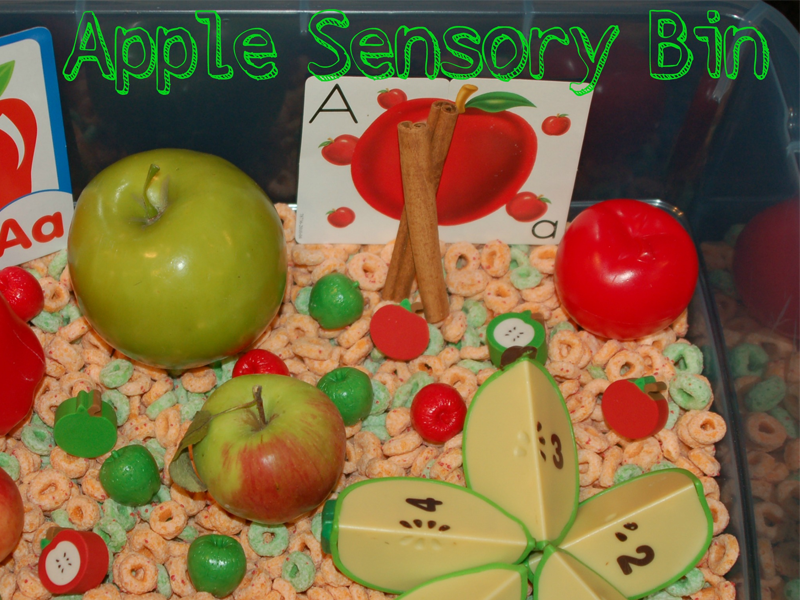
วัสดุ
- Plastic bin
- Plastic fruit toys or felt fruit cutouts
- Dyed rice or oats as a base
- A few drops of fruit extract (like strawberry or lemon)
- Cups, bowls, and scoops
How to Make It
- Fill the bin with dyed rice or oats.
- Add a small amount of fruit extract to create a gentle scent.
- Mix in the plastic or felt fruits.
- Offer tools like bowls and scoops to mimic grocery or kitchen play.
17. Gardening Bin
การแนะนำ
This sensory bin brings the outdoors inside, helping toddlers connect with nature while practicing digging and planting motions. Perfect for spring or plant-themed preschool lessons.
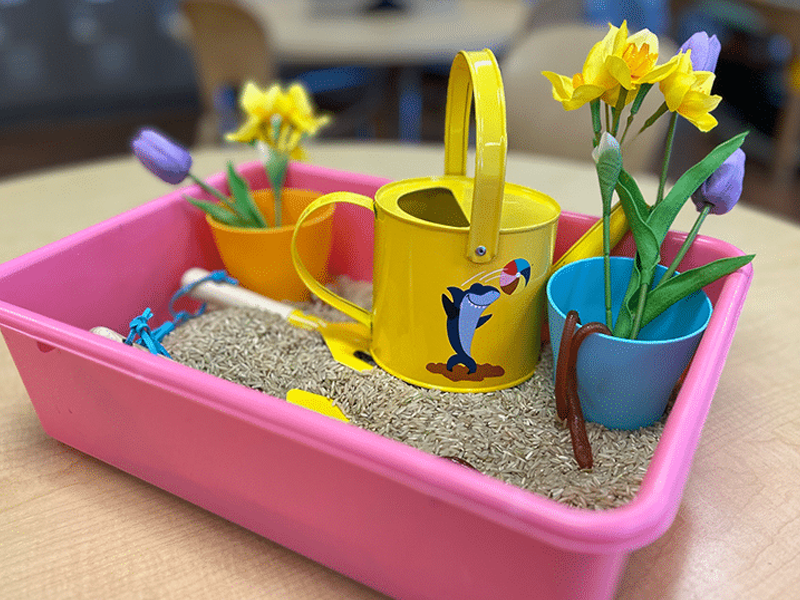
วัสดุ
- Plastic bin
- Potting soil or used coffee grounds
- Faux flowers or plastic plants
- Mini gardening tools (rake, spade)
- Small flowerpots or cups
How to Make It
- Fill the bin with a layer of potting soil or coffee grounds.
- Insert artificial flowers or provide them separately.
- Add tools and pots.
- Let toddlers dig, “plant,” and rearrange their garden.
18. Arctic Ice Bin
การแนะนำ
This bin introduces toddlers to cold temperatures, smooth textures, and simple cause-and-effect play (like melting ice). It’s a significant winter-themed sensory bin for preschool settings.
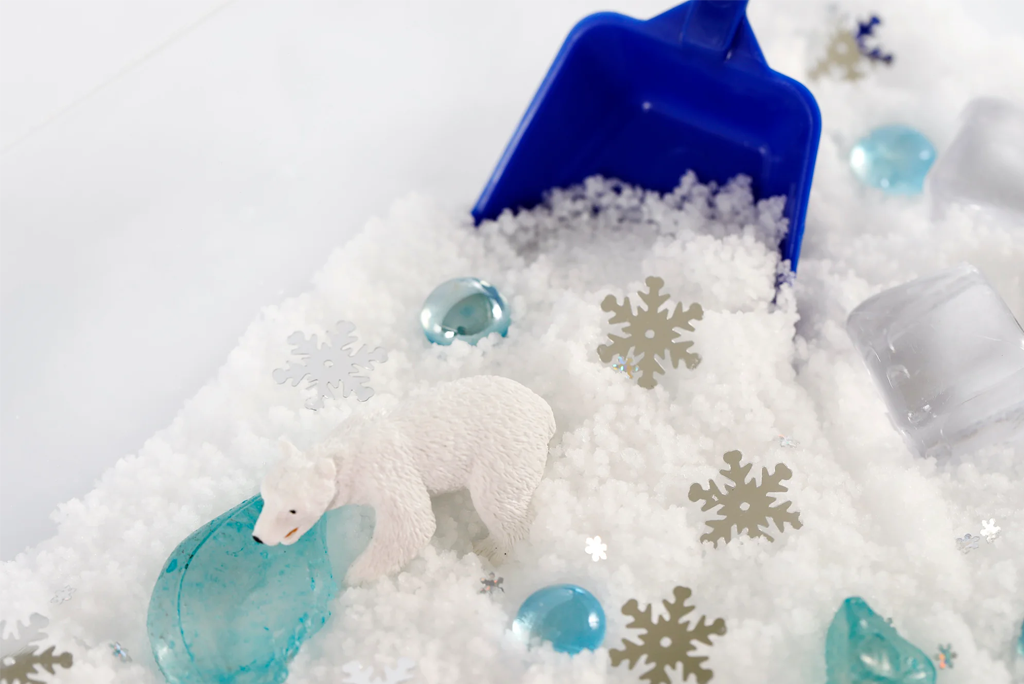
วัสดุ
- Spoons or ladles
- Ice cubes
- Plastic animal figurines (penguins, polar bears, etc.)
- Blue-dyed water (optional)
- Plastic bin or tray
How to Make It
- Fill the bin with a shallow layer of ice cubes.
- Place animal figurines on top of or in between cubes.
- Optional: Add a small amount of blue-colored water.
- Let toddlers explore the cold, slide animals, and watch the melting process.
19. Alphabet Soup Bin
การแนะนำ
A significant early literacy bin that combines sensory play with letter recognition. Toddlers “scoop” letters out of water and begin identifying sounds, shapes, and sequences.
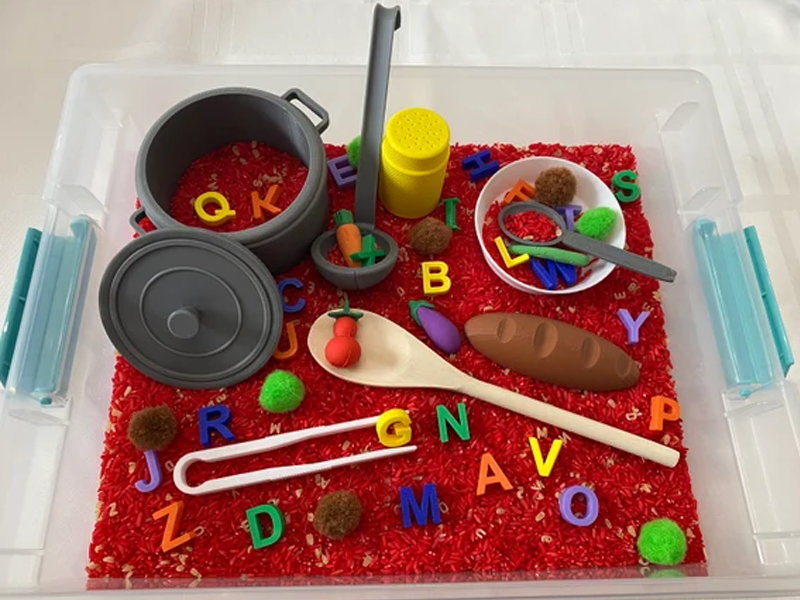
วัสดุ
- Optional: Plastic bowls for collecting letters
- Foam or plastic alphabet letters
- Plastic ladles or strainers
- Large bowl or bin with water
How to Make It
- Fill the bin with water and toss in the alphabet letters.
- Provide scoops or ladles for collecting the letters.
- Ask toddlers to name the letters as they scoop them out.
- Encourage matching with printed letters if appropriate.
20. Pasta and Strainer Bin
การแนะนำ
This fine motor-focused bin encourages toddlers to thread and insert pasta into holes, promoting concentration and control. It’s a quiet activity that works well in individual or small group play.
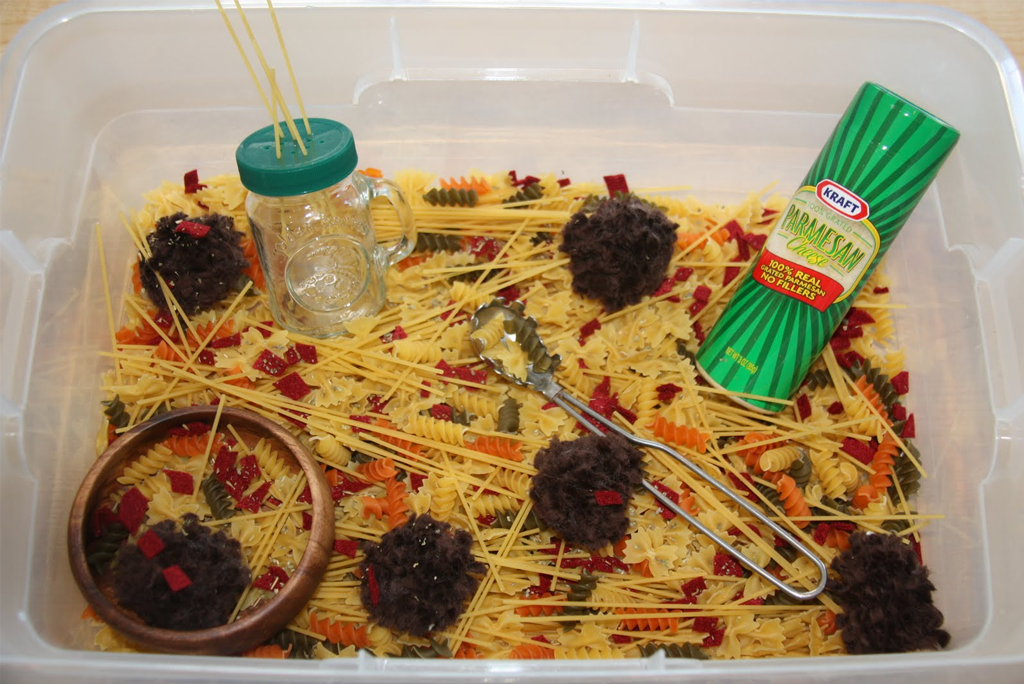
วัสดุ
- Tray or bin to contain the setup
- Uncooked spaghetti or penne pasta
- Colanders or baskets with holes
- Small tongs or fingers for threading
How to Make It
- Place pasta in a container next to a colander or strainer.
- Show toddlers how to push or thread pasta through the holes.
- Allow them to explore freely, improving focus and dexterity.
- Refresh materials as needed if pasta breaks.
พร้อมที่จะออกแบบพื้นที่ที่สร้างแรงบันดาลใจในการเรียนรู้หรือยัง ติดต่อเราเพื่อสร้างโซลูชันเฟอร์นิเจอร์ที่ปรับแต่งให้เหมาะกับความต้องการในห้องเรียนของคุณ
21. Colorful Button Bin
การแนะนำ
This visually stimulating sensory bin helps toddlers practice sorting, color matching, and fine motor control. It’s a great introduction to early math concepts like categorization.
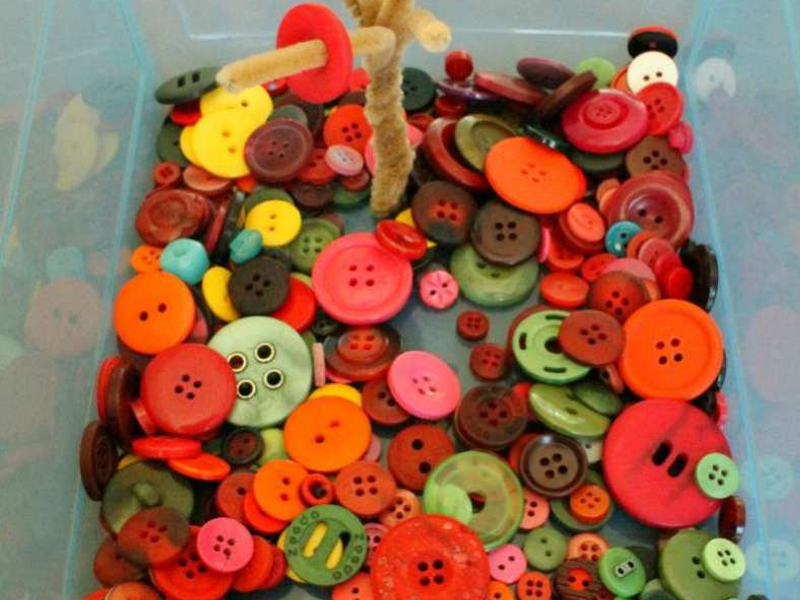
วัสดุ
- Medium-sized plastic bin
- Large, colorful plastic buttons
- Dry rice or oats as a filler
- Color-coded cups or bowls
- Scoops or tongs
How to Make It
- Fill the bin with your chosen filler (rice or oats).
- Mix in the plastic buttons.
- Set out matching colored cups next to the bin.
- Let toddlers find, sort, and transfer the buttons by color.
22. Farm Animal Bin
การแนะนำ
A classic pretend-play sensory bin that introduces animal sounds, names, and environments. It’s a toddler favorite that promotes both language and imaginative play.
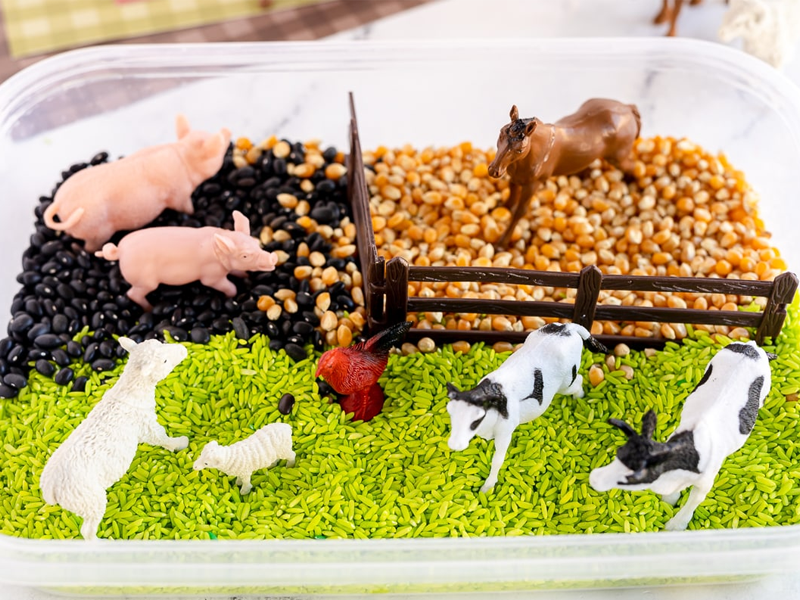
วัสดุ
- Bin or tray
- Dry corn kernels or oats
- Plastic farm animal figurines
- Small fences or barns (optional)
- Scoops and small bowls
How to Make It
- Fill the bin with a layer of oats or corn kernels.
- Place farm animals around the bin.
- Add scoops and accessories like toy fences.
- Encourage toddlers to name the animals and create little farm stories.
23. Fabric & Ribbon Bin
การแนะนำ
This soft-texture bin is excellent for babies and younger toddlers, offering safe sensory input without any small parts. It encourages exploration of different textures and colors.

วัสดุ
- Optional: Add scent (lavender sachet, vanilla cloth)
- Fabric scraps in various textures (cotton, silk, felt)
- Ribbons of different lengths and widths
- Medium bin or basket
How to Make It
- Cut and gather multiple fabrics and ribbons.
- Place them loosely in the bin.
- Encourage toddlers to touch, crinkle, wave, or sort by texture.
- Supervise closely to avoid wrapping hazards.
24. Ocean Bin
การแนะนำ
This aquatic-themed sensory bin offers both visual stimulation and rich pretend play. Toddlers can learn about sea creatures while exploring watery textures and fluid movement.
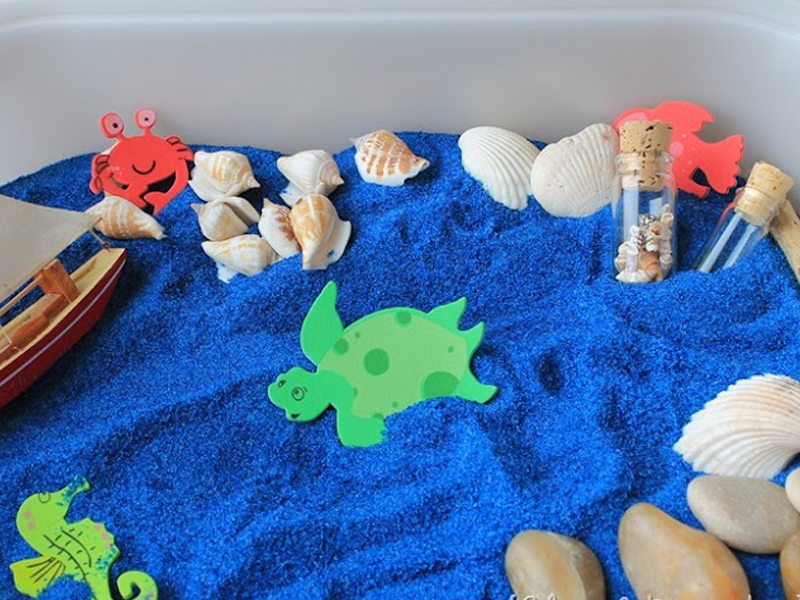
วัสดุ
- Cups, nets, or ladles
- Blue-dyed water
- Plastic fish, sea turtles, or shells
- Clear container or bin
How to Make It
- Add blue food coloring to water in a bin.
- Place sea-themed toys in the water.
- Add scoops, nets, or cups for exploration.
- Invite toddlers to “rescue” animals, sort by type, or just splash freely.
25. Dino Dig Bin
การแนะนำ
Toddlers love dinosaurs, and this dig-and-find activity taps into that curiosity. It promotes both sensory exploration and early STEM concepts like excavation and classification.
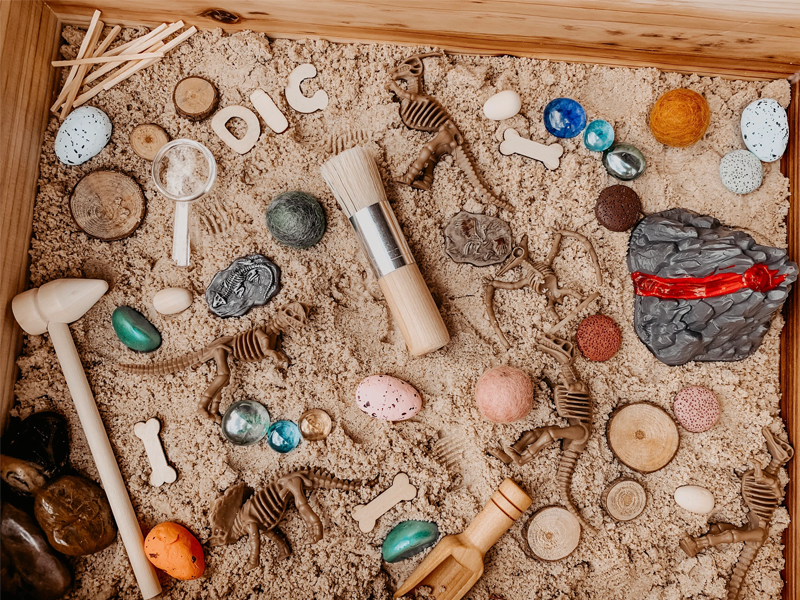
วัสดุ
- Plastic bin
- Kinetic sand or dry brown rice
- Plastic dinosaur figurines
- Small paintbrushes or scoops
How to Make It
- Fill the bin with a layer of kinetic sand or rice.
- Bury dinosaurs at different depths.
- Provide brushes and scoops for “excavation.”
- Encourage toddlers to find, name, and group the dinosaurs.
26. Jelly Smash Bin
การแนะนำ
This messy and exciting sensory bin is perfect for toddlers who love to squish and squeeze. It’s ideal for tactile exploration and builds finger strength through playful resistance.
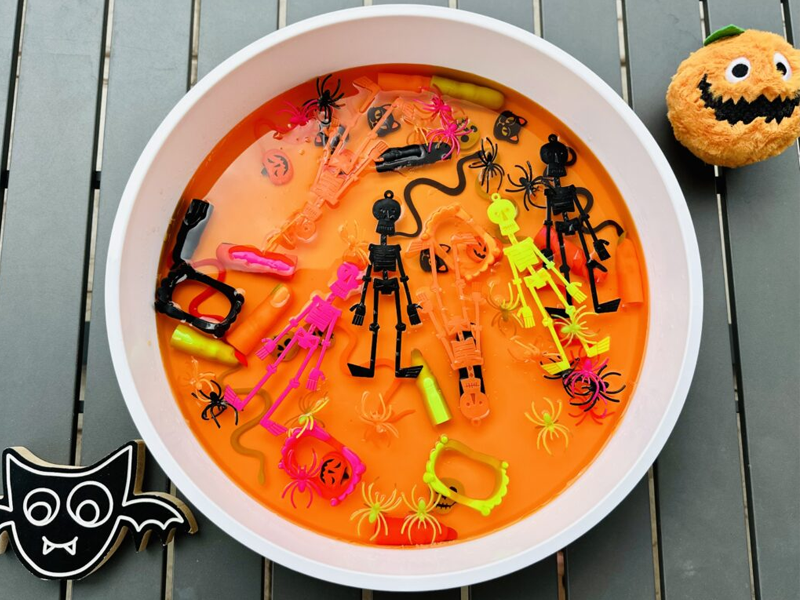
วัสดุ
- Towels or a tray underneath for mess control
- Prepared gelatin (any color)
- Small plastic toys (washable)
- Large shallow bin
How to Make It
- Prepare gelatin according to package instructions and pour it into the bin.
- Before it sets, drop in clean plastic toys.
- Refrigerate until firm.
- Let toddlers dig through the jelly, using fingers to squish and reveal surprises.
27. Baking Theme Bin
การแนะนำ
Toddlers can pretend to bake muffins or cakes while working on motor planning, scooping, and pouring. This bin is perfect for dramatic play and sensory engagement.
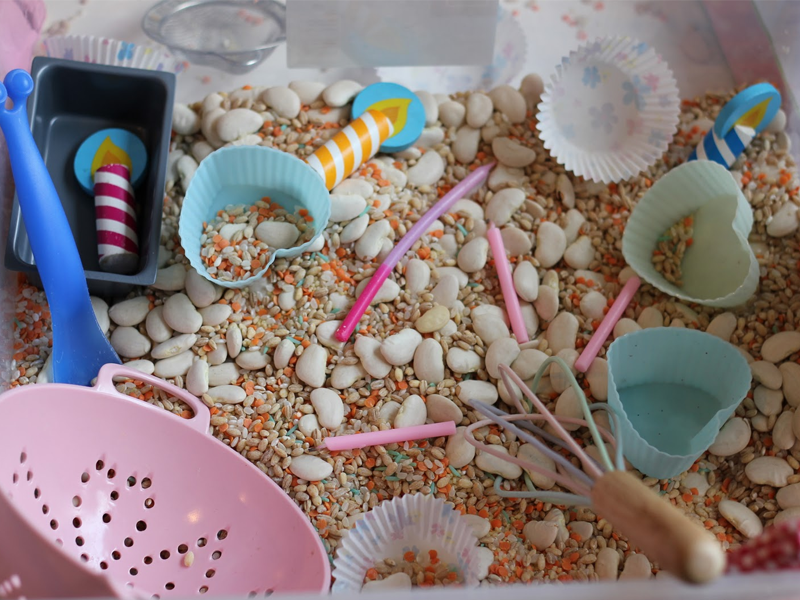
วัสดุ
- Medium bin or tray
- Flour or cornstarch (as the base)
- Measuring spoons and cups
- Silicone cupcake liners or muffin tins
- Wooden or plastic mixing tools
How to Make It
- Pour flour into the bin to create a “baking surface.”
- Add tools and cupcake liners.
- Encourage toddlers to scoop, pour, mix, and fill the liners like they’re baking.
- Optional: Add cinnamon for a baking scent.
28. Shredded Paper Surprise
การแนะนำ
This fun yet straightforward bin encourages toddlers to search, dig, and explore with their hands. It’s also a great way to introduce fundamental concepts like “hidden vs. visible” and encourage surprise discovery.
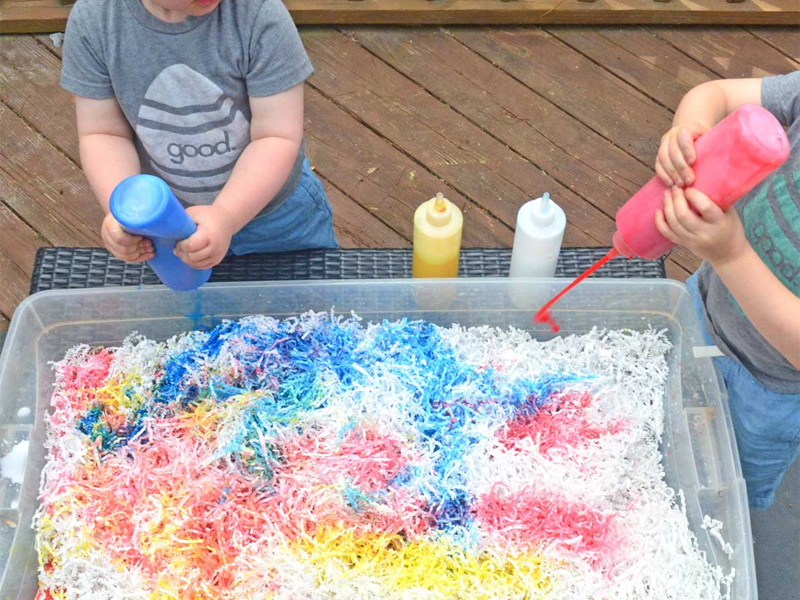
วัสดุ
- Bowls or tongs (optional)
- Clean shredded paper (from a shredder or hand-cut)
- Small toys or objects to hide (balls, animals, letters)
- Medium bin
How to Make It
- Fill the bin with shredded paper.
- Hide toys throughout the layers.
- Invite toddlers to dig with their hands or use tongs to find surprises.
- Encourage them to name each item as they find it.
29. Magnet Bin
การแนะนำ
A science-themed sensory bin for toddlers that adds a bit of STEM exploration. This activity builds curiosity and cause-and-effect understanding using magnetism.
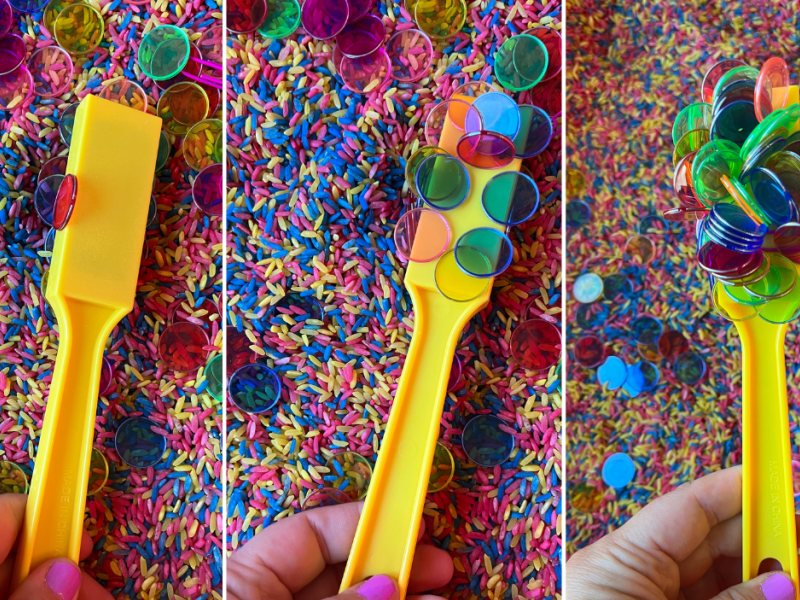
วัสดุ
- Medium-sized bin
- Magnetic wand
- Magnetic and non-magnetic items (plastic-coated paper clips, metal washers)
- Rice or beans as a base
How to Make It
- Fill the bin with rice or beans.
- Mix in a variety of magnetic and non-magnetic objects.
- Give the child a magnet wand to search through the bin.
- Talk about what sticks and what doesn’t.
30. Ice Cream Shop Bin
การแนะนำ
This pretend-play bin encourages creativity, language, and social-emotional skills. Toddlers can act out serving ice cream while building fine motor control with scoops and pom-poms.
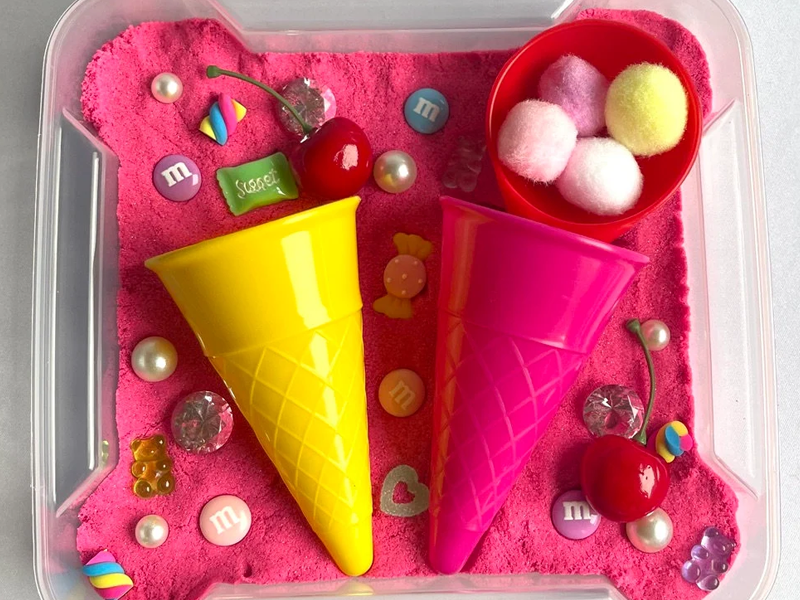
วัสดุ
- Pom-poms in different colors (ice cream scoops)
- Plastic ice cream cones or bowls
- Scoops or tongs
- Menu cards or play money (optional)
- Plastic bin
How to Make It
- Fill the bin with colorful pom-poms.
- Set out cones, bowls, and scoops.
- Let toddlers “scoop” and serve ice cream to each other.
- Add pretend play elements like a menu for extended fun.
Different Types of Sensory Bins for Toddlers
Lidded Sensory Bins
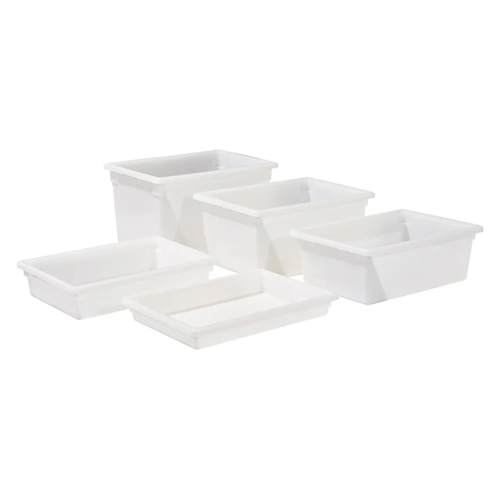
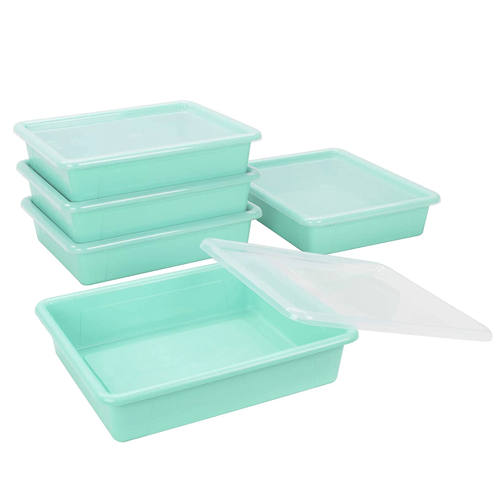
Lidded sensory bins are a practical choice for both home and classroom use. Their biggest advantage is that they keep materials contained, making storage and cleanup simple, which is especially helpful in busy daycare centers or shared learning spaces. These bins are available in a variety of depths and base sizes, usually between 40 by 60 centimeters and 60 by 90 centimeters. Depending on the need, they can be shallow at around 10 to 15 centimeters, standard at 20 centimeters, or deep at 30 centimeters or more.
Best For
Sensory bins for 2-year-olds and 3-year-olds benefit from shallow styles, while deeper bins can accommodate more complex setups for preschoolers or sensory bins for 4-year-olds. The lid also allows you to pre-prepare bins for daily rotations or store ongoing projects.
Dual-Compartment Wooden Sensory Table
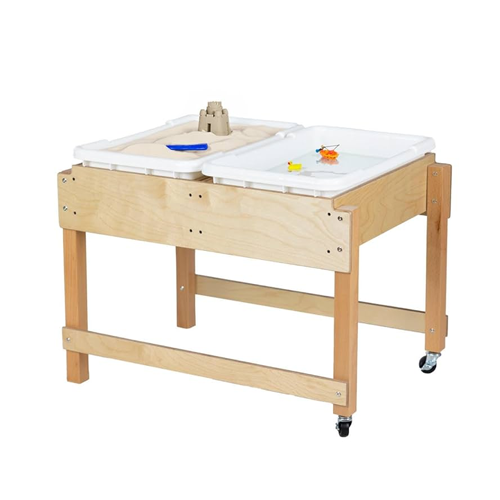
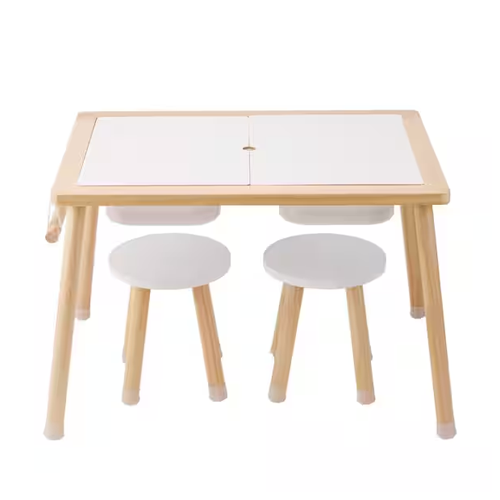
Wooden sensory tables with two compartments allow for multi-activity setups. Such as dry/wet separation, collaborative play, or theme-based bin rotation. The natural wood finish complements Montessori and Reggio-inspired classrooms.
Best For
Great for sensory bins for 2-3 year olds, this design supports dual exploration, like rice on one side and pom-poms on the other. It’s a เฟอร์นิเจอร์โรงเรียนอนุบาล essential for centers that emphasize sensory learning.
Plastic Water Tray with Drain Plug
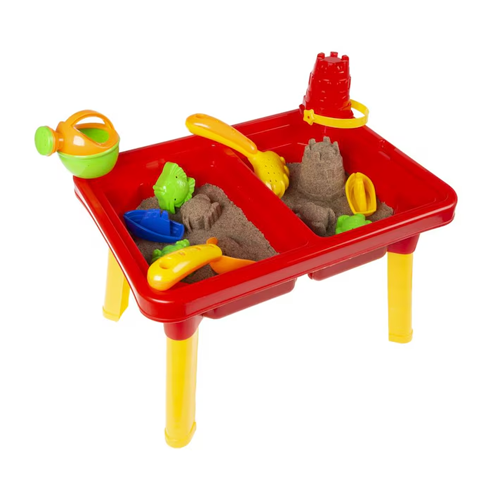
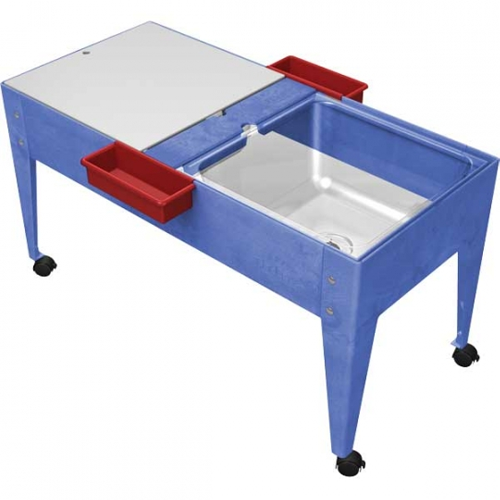
This plastic tray is designed for wet sensory play with water, ice, bubble foam, or water beads. A built-in drain plug makes cleanup quick and sanitary, especially in classrooms with multiple age groups.
Best For
Common in sensory bins for toddlers, mainly when used outdoors or in water-themed activity centers. Its ease of use also suits sensory bins for 15-month-old and 18-month-old children who are beginning water exploration.
Rolling Sensory Bin Cart with Locking Wheels
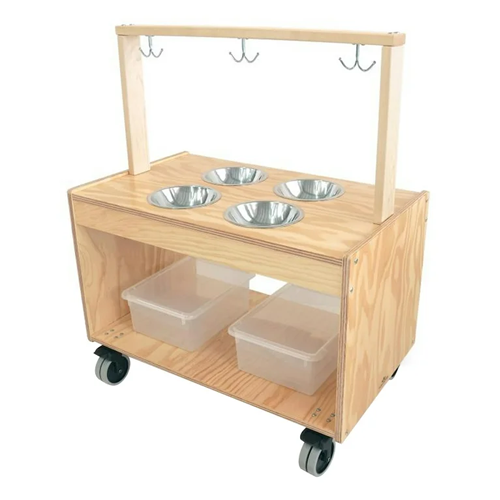
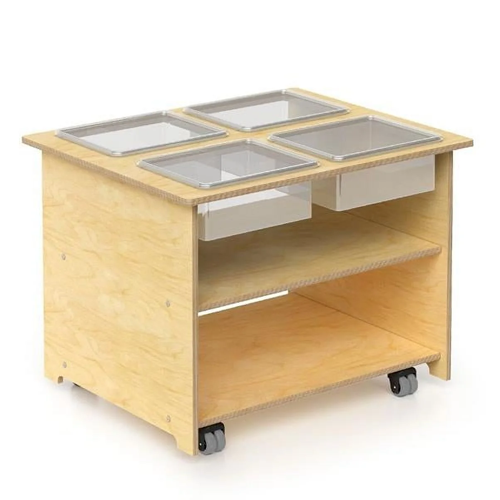
Ideal for mobile classrooms or shared activity zones, sensory carts allow teachers to move bins from storage to play areas with minimal setup. Locking wheels provide safety during use.
Best For
An excellent fit for sensory bin toddler settings that require flexibility, especially in centers where space is tight. Carts are often used to rotate sensory bins for preschoolers across different classrooms or stations.
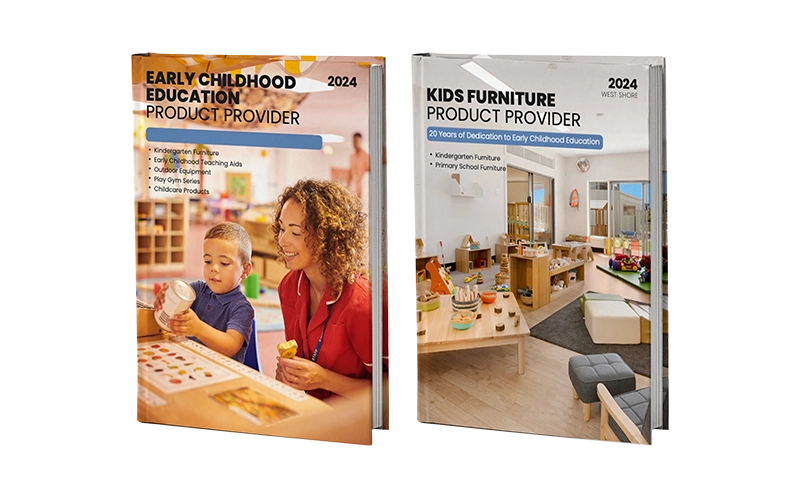
Safety Tips When Using Sensory Bins for Toddlers
Sensory Bins for Toddlers are fun and educational, but they must be used safely. With the proper setup and supervision, they become a secure space for meaningful play.
Supervision Is Essential
All Sensory Bins for Toddlers must be used under constant adult supervision. Toddlers are naturally curious, and even the safest bin materials can pose a risk if unsupervised, especially in group settings like preschools or daycare centers.
Choose Safe, Non-Toxic Materials
Every material used in Sensory Bins for Toddlers should be large enough to avoid choking hazards and free from sharp edges or toxic chemicals. Edible fillers or oversized objects are best for younger age groups.
Use the Right Bin Size and Height
To reduce tipping and encourage safe posture, sensory bins for toddlers should be shallow, stable, and placed at a comfortable height, especially when used with children between 2 and 3 years old who are still refining motor control.
Clean and Sanitize Regularly
Regular cleaning of Sensory Bins for Toddlers prevents the spread of germs in high-use environments. Water bins should be emptied daily, and solid materials like rice or pasta should be replaced weekly or as needed.
Be Cautious About Allergens
Some ingredients used in Sensory Bins for Toddlers, like flour, lentils, or scented oils, can trigger allergic reactions. Always review allergy information and consider using hypoallergenic or synthetic alternatives.
Creating Sensory Experiences
From fine motor development to imaginative storytelling, Sensory Bins for Toddlers offer a powerful combination of tactile engagement and early learning. Across classrooms, homes, and early education centers, these bins provide age-appropriate opportunities for toddlers to play, focus, and grow while giving educators flexible tools to support curriculum goals through sensory exploration.
For preschools, kindergartens, and early learning environments that value structure, safety, and creative play, choosing the right equipment matters just as much as the activity itself. That’s why many institutions partner with experienced furniture manufacturers like West Shore Furniture, whose thoughtfully designed sensory tables, acrylic bins, and storage solutions seamlessly support the practical demands of daily sensory play, especially for programs offering sensory bins for 2-3 year olds, preschool sensory bins, or age-specific setups such as sensory bins for 4 year olds.
คำถามที่พบบ่อย
1. Are Sensory Bins safe for 2-year-olds?
Yes—sensory bins for 2 year olds are safe when designed properly. Use large, non-toxic materials, avoid choking hazards, and always supervise. Great filler options include pom-poms, edible cereal, or large pasta shells.
2. What types of bins or tables are best for classroom use?
For preschools and daycare centers, sturdy wooden tables, stackable plastic trays, or mobile carts with locking wheels are ideal. Many classrooms use shallow sensory bins with lids or dual-compartment tables to accommodate multiple activities and age groups.
3. How often should sensory materials be changed or cleaned?
Liquid-based bins like water or foam should be emptied and sanitized daily. Dry fillers like rice or beans can be reused for several days if stored properly. All Sensory Bins for Toddlers should be inspected and refreshed regularly to maintain hygiene and safety standards.
4. How can I adapt Sensory Bins for 3 to 4 year olds?
Sensory bins for 3 year olds and sensory bins for 4 year olds can include more complex themes like alphabet matching, simple science experiments, or pretend play. Use tools like tongs, sorting trays, or themed props to increase challenge and encourage creativity.

